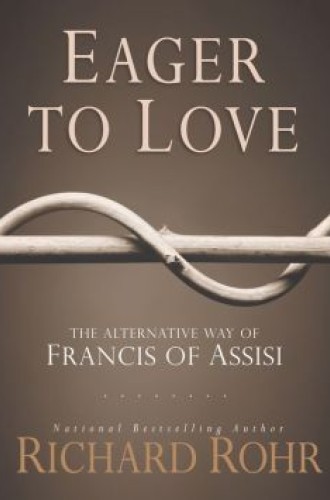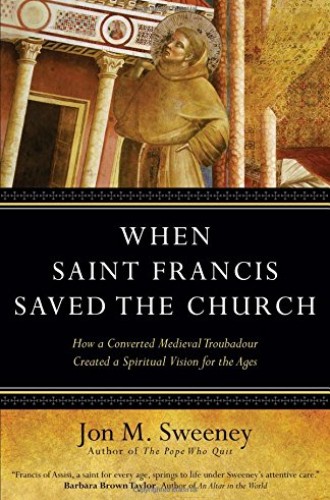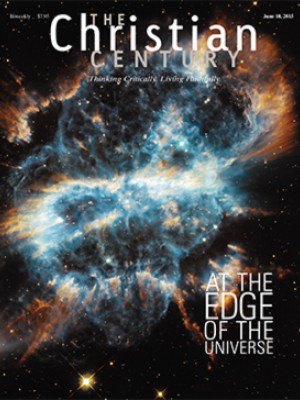Eager to Love, by Richard Rohr, and When Saint Francis Saved the Church, by Jon M. Sweeney
Near the azaleas in front of the first house we owned, my wife and I put a small statue of St. Francis, his arms holding a basket of birdseed. When we sold the house two years later, we forgot to take the statue. For the next several years, whenever we would drive by, we would contemplate whether we should have one of our kids dash into the yard and retrieve our Francis.
Richard Rohr and Jon Sweeney, the authors of two new books on St. Francis, would be united in this advice to us: forget the statue. “Birdbath Franciscanism,” as Rohr calls it, is only preventing you from learning from the real St. Francis. And now that we have a pope named Francis, Rohr and Sweeney believe there’s no better time to rediscover the real St. Francis and his relevance for today. Each author sets out to paint a portrait of the real Francis’s spiritual vision.
Read our latest issue or browse back issues.
Fans of Rohr’s work will be glad he did. In Eager to Love, Rohr outlines the contours of what he takes to be the authentic Franciscan way, which turns out to look uncannily like the spiritual vision Rohr himself has been articulating for decades. Francis is an exemplar of what Rohr calls mature religion. He writes, “Mature religion serves as a conveyor belt for the evolution of human consciousness. Immature religion actually stalls us at very low levels of well-disguised egocentricity.” Rohr associates Francis with a highly evolved human consciousness.
Here’s how Francis’s evolution looks in Rohr’s hands: Francis suffered a “necessary fall” that forced him to question the identity he’d established for himself (see Rohr’s book on the two halves of life, Falling Upward); that experience freed him from attachments so he could live a life of abandon, trust, and utter availability to God and others (see Rohr’s book on the spirituality of the 12 steps, Breathing Under Water); freed from attachments to his false self, Francis could live out of his true self (see Rohr’s book on the true self, Immortal Diamond); and as one living out of the true self that is “hidden with Christ in God” (Col. 3:2), Francis saw with contemplative vision beyond the dichotomies the rest of us use to filter reality (see Rohr’s book on mysticism, The Naked Now). Eager to Love ends up being a kind of summus Rohrus—the major themes of Rohr’s own spiritual vision siphoned through Francis to form a coherent whole.
What distinguishes this book from Rohr’s others are the chapters on Bonaventure and John Duns Scotus and the three appendices—essentially extra chapters—dealing with the cosmic Christ, the personhood of God, and divine causality. Here Rohr addresses theological themes in more depth than his readers will be used to. Those themes include Scotus’s “univocity of being” and an account of divine causality called “exemplary causality”—think process theology’s wooing God. The former is necessary for a nondualistic view of God and creation, Rohr says, and the latter is necessary for a proper understanding of the relationship between divine and human freedom.
It is in these chapters on theological themes that Rohr is the most interesting because he shows his theological cards, but also the most troubling. Troubling because I wonder if he knows what he’s talking about when he says things like: “It is formally incorrect to say ‘Jesus is God,’ as most Christians glibly do. Jesus is a third something, which is the union of ‘very God’ with ‘very man.’” But the doctrine of the unity of the divine and human in the one person of Jesus is the grounds on which we can say “Jesus is God” precisely because Jesus is not some third thing. When I see a clearly wrongheaded theological claim like Rohr’s, it makes me suspicious when he talks about univocity of being and divine causality. Can we trust his insights here?
Fortunately, we don’t read Rohr for these things. We read him for his contemplative vision, and I do not believe that his vision stands or falls on the adequacy of these theological claims. In fact, I believe one could make a better case for a nondualistic contemplative vision on the basis of the Thomistic Christology and metaphysics that he rejects.
Sweeney’s When Saint Francis Saved the Church shares with Rohr a general account of Francis as one who sees beyond and thus lives beyond the dualisms that so shape us—sacred and secular, life and death, us and them. In the hands of Sweeney, a master popular historian, Francis’s vision seems real, relevant, and practical—perhaps too much so. That vision, which Sweeney summarizes in six key themes—Francis’s view of friendship, his embrace of the other, his love of poverty, his making spirituality available to everyone, his love of creation, and his embrace of death—sparkles in the hands of a sympathetic historian and graceful writer.
Two things strike me about Sweeney’s book. First, the author is clearly a trustworthy guide. He knows the historical documents relating to Francis as well as anyone, I suspect, and he pays more attention to what little we can know to be true of Francis’s life than to the myths and fables about him. Getting the balance between these two is a challenge for anyone working on the history of figures about whom we have immeasurably more material from the decades following their lives than from the years in which they lived. For an earlier book Sweeney translated and edited the few documents that scholars generally agree are from Francis’s own hand, and these carry more weight for Sweeney than the words of later biographers and hagiographers.
Second, as a popular historian Sweeney knows the necessity of imaginatively and sympathetically entering the world of the subject. He takes readers into the medieval world in order to highlight the uniqueness of Francis’s life—as he does, for example, in the chapter on Francis’s embrace of death. The idea that we might befriend death seems almost a modern cliché, however far we are from doing so. But Francis remarkably welcomed “sister death” in a culture in which terror mortis, the fear of death, was at the heart of the Christian life. This welcome shows that Francis had broken through to a God he could befriend as well. Death is to be feared only when the God we will meet in death is not a friend.
Not that there’s nothing to quibble with here. Although Sweeney depicts Francis as a nondualistic thinker, he employs the opposing categories of spirituality and religion, painting a picture of Francis as a champion of spirituality over religion (Rohr does the same). Although Sweeney notes that the category of spirituality is anachronistic when applied to Francis, this opposition still colors the portrait he creates. Maybe the need to show Francis’s relevance compels Sweeney to use categories that are familiar to today’s readers. But wouldn’t Francis seem more relevant if we could see how his vision of the Christian life challenges the categories we so easily accept?
I also wonder whether the push for relevance leads to the whitewashing of some aspects of Francis’s life and vision. His ascetic discipline was extreme. He ate little, deprived himself of sleep, and sometimes punished his body. Here’s how Sweeney deals with this aspect of his life: “He often referred to his body as Brother Ass, for the troubles it gave. We all feel that way from time to time, wishing that we wouldn’t get so tired so easily, or could do more. Francis would prod his body along, speaking to it as if it were a stubborn ass.” That seems a less than honest account of a troubling aspect of Francis’s spirituality that doesn’t fit nicely into a nondualistic vision. Neither, by the way, does the line in Francis’s “Canticle of the Creatures,” “Woe to those who die in mortal sin,” which neither Rohr nor Sweeney deals with.
Under the auspices of offering the real Francis, both books present a Francis who looks suspiciously like the author (in Rohr’s case) or like contemporary spirituality (in Sweeney’s case), which means there’s much more still to learn from Francis.
But there is a beauty in both books as well, and the beauty wins the day. Here are two compelling, winsome, and complementary portraits that make me want to lay aside my tendency toward theological and historical quibbling—an example of the very dualistic thinking Francis can teach me to outgrow?—and live a life like his.
With or without the statue.







